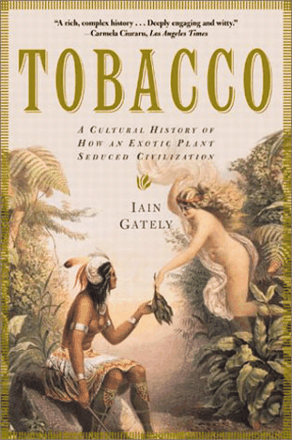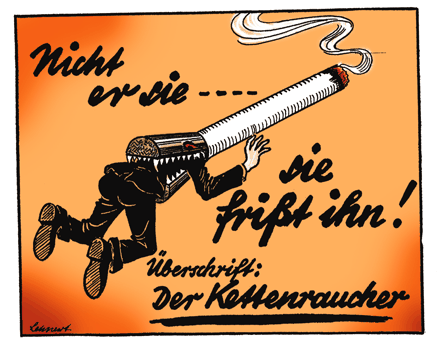“Dry Drinking” the Devil’s Weed
Tobacco: A Cultural History of How an Exotic Plant Seduced Civilization. Iain Gately. New York: Grove Press; 2003. 416 pages.$15.00. ISBN: 0802139604

Tobacco, the phoenix’s antithesis—raised to be burned—has been part and parcel of human civilization for centuries. Because the ways in which tobacco has weaved itself into the fabric of Western civilization are so numerous, subtle, and pervasive, we easily lose sight of tobacco’s influence beyond the obvious social–medical cues of smoking, such as smoking for acceptance (whether for friendship, fashion, or rite of passage), smoking for “relaxation,” and the dangers manifested by long-term smoking. Indeed, from tribal usage to its use as a pleasure-giving product, and from its use as a good of trade, to a product so greatly coveted that its want effected wars, tobacco continues to influence the lives of nearly all consumers, including non-smokers. Iain Gately’s book on tobacco informs and instructs with wry humor and covers the gamut of tobacco from pre-history to the present.
Gately, himself a smoker, begins with a history of tobacco in shamanic rites: tobacco was used as a medicine and a conduit to the spirit world, especially in conjunction with hallucinogenic concoctions. Of interest here is the method by which tobacco is ingested. Climate controls the method by which several peoples have used tobacco for divination. The rarified air of the Andes tends to make smoking difficult; therefore the method of choice for tobacco ingestion among Incans was snuffing. On the other hand, in the humid swamplands of the Amazon, tobacco was pulverized and imbibed as an extract.
A long and descriptive account is offered of Columbus’s confrontation with tobacco among the people of the West Indies; how the Spanish clergy associated smoking tobacco with Satan and hellfire (abetted by the natives’ admissions that the tobacco helped them communicate with devils and spirits); and the introduction of tobacco to Europe including each royal house’s need to prevail in one-upmanship.
In the late sixteenth century, English smokers, to the dismay of non-partakers, tended to smoke themselves into a stupefaction resembling drunkenness; thus, the practice of smoking tobacco was termed “dry drinking.” In 1604, James I of England turned his intolerant gaze toward tobacco. In his splenetic “A Counterblaste to Tobacco,” King James described what might be considered the first description of addiction, albeit wearing the dress of sin. James’s hatred of tobacco led to a 4000% increase in duty taxes on imported tobacco, but notably, tobacco production was not outlawed. Therefore, the need to expand tobacco cultivation within England and its various colonial outposts increased. The colony at Jamestown, Virginia, had failed to thrive during two preceding attempts at settlement. However, third time’s the charm. John Rolfe planted tobacco seeds he had obtained from Trinidad; through trial, error, and shrewd calculation, Rolfe grew enough tobacco of premium grade and flavor that soon Virginia tobacco—carrying the first known usage of a brand name from the colonies: “Orinoco”—gained precedence in England. This is an eyebrow-raising gloss over history, but it nonetheless does point to the utter dependence of the early East Coast settlement on tobacco for survival. In effect, sustainable growth of tobacco begat sustainable growth of Jamestown and later, a number of colonies. Soon, instead of perpetual denigration as a primitive backwater, the colonies and their potential for economic boon (for England) began paying off. As the need for manpower increased, the Dutch—ever pragmatic and opportunistic—brought and traded slaves for colonial goods. Thus, Gately observes, tobacco helped establish English interests on the east coast of the North American continent, brought slavery to the colonies, and gave rise to “the most imitated nation in history.” In fact, the recurrent theme in the first half of Tobacco refers to the plant’s influence on geopolitical balances of power, mercantilism, and nation building.

“A country’s reaction to the introduction of tobacco was highly revealing of its national character. The French used it to
ward off illness and preserve beauty; in the Italian states, it was entrusted to the care of the priests and administered
on their advice; in the German principalities it was examined in accordance with the best current scientific principles and
declared a ‘violent herb’; in Switzerland it was tested first on a dog before being recommended for human consumption. One
European country [England], however, focused on an entirely different justification for tobacco use: pleasure.”
Unquestionably, Jean Nicot gave rise to tobacco’s wide popularity. In an attempt to show tobacco had medicinal value, Nicot considered Galen’s four humors, which consisted of combinations of cold, hot, wet, and dry. For example, phlegm was considered a cold and wet affliction. Thus, if tobacco smoke could be considered hot and dry, then smoking could be promoted to help bring the body back into balance by offsetting the cold wetness of phlegm. Luckily for Nicot, tobacco’s expectorant effects reduced phlegm in willing subjects. More amazingly, Nicot is said to have rubbed extracts of tobacco on skin tumors found on different people and effected their complete regression. Sufficiently emboldened, Nicot sent tobacco seeds to the Queen of France who, soon afterwards, endorsed tobacco’s health effects, causing a wave of tobacco-taking fashion throughout the court. It is, of course, in Nicot’s honor that the tobacco genus bears his name.
Fun Facts Guaranteed to "Break the Ice" at Parties!
Of the sixty-five species of tobacco, only two_N. rustica and N. tabacum_are used by mankind for smoking.
Both of these species are native to the Americas.
Mankind discovered tobacco about 18,000 years ago, butits first cultivation most likely occurred in the Peruvian-Ecuadoran Andes between 5,000 and 3,000 BCE.
The osmotic capacity of human lungs is greater than fifty times that of the human palate or colon.
In 1939, German scientists used epidemiological methods to link smoking with lung cancer.
“[English] [t]obacconists were expected to possess a lengthy repertoire of tricks involving a combination of facial contortions
and the expulsion of carefully shaped tobacco clouds. A new art evolved, dedicated to the perfect smoke ring.”
In a later chapter, Gately describes the opening of niche markets for specific cigarette smokers. Mentholated cigarettes were created as early as the 1930s, but did not reach mainstream popularity until the production of Kool cigarettes. Peppermint oil had been used by veterinarians as a local anesthetic, and the use of oil of peppermint promised to alleviate the symptoms of a smoke-irritated larynx. Now, disenfranchised smokers could join the fray again. Additionally, we are told that filters used in Kent cigarettes consisted of “micronite,” known better to you and me as asbestos. Lastly, because R.J. Reynolds worried that filters would remove most of the taste from their cigarettes, RJR added tar and nicotine back…into the filters. Now they’d taste good, like a cigarette should! (My apologies to Winston cigarettes.)
There are too many examples and anecdotes in this enormously detailed book to effectively review all its aspects. Indeed, the book covers the image of tobacco through Hollywood’s lens; a tie-in between addiction and the beginnings of psychoanalysis; the soldier and his tobacco in modern warfare; Big Tobacco’s campaign to hoodwink the American public; unabashed product placement; and an appendix on growing tobacco at home that High Times would be proud of.
This American paperback edition would have benefited from light, if careful, editing. There are occasional irritating lapses of detail on topics that deserve a few more lines. For example, “[S]ome of the plains tribes, including the Blackfoot and the Crow, to whom growing vegetables was anathema, planted and nourished [tobacco].” Elsewhere, obvious statements abound: “Christopher Columbus, a Genoese sea captain,…” Grove Press has probably not changed the text from what is surely the original text printed in Great Britain, and we are thus ambushed with a surfeit of British-English usage, spellings, and things with which British readers will be culturally familiar. Nonetheless, overall, Tobacco is a terrific smoke.
- © American Society for Pharmacology and Experimental Theraputics 2003

John Nelson, PhD, a nonsmoker, is Associate Editor of Molecular Interventions.



